#robber bridegroom
Explore tagged Tumblr posts
Text
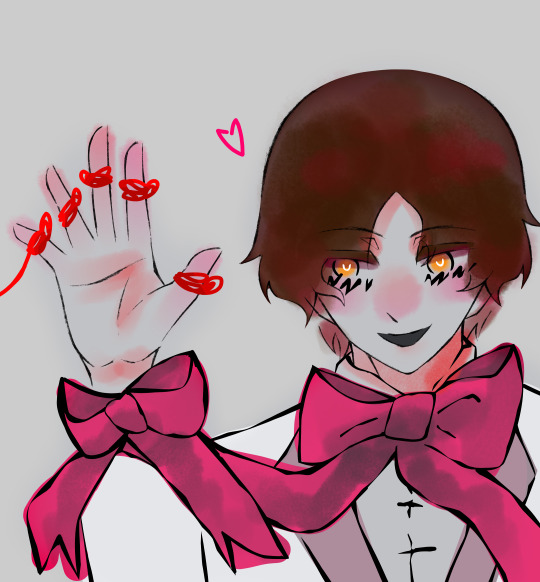
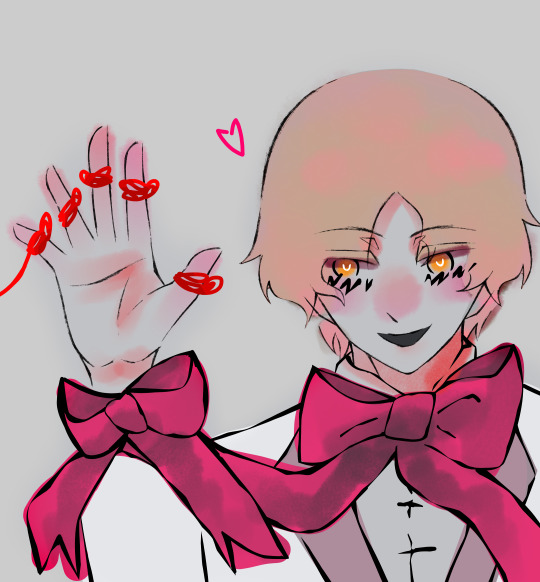
1.20.24
Caught a bite
#oc#original character#my art#art#digital art#drawing#illustration#artists on tumblr#bridegroom#robber bridegroom
13 notes
·
View notes
Text
(of course this was recommended on pinterest for josephine’s board…)

4 notes
·
View notes
Text
The Dangers of Blue Beards (in Books)
Bluebeard Retellings and Reimaginings As I’m sure you all know I’m not a folklorist or anything like that, but I LOVE folktales and stories, and I think in worldbuilding one of the best and most fun ways to get to grips with a culture is by imagining what stories people tell about themselves and their world. In The Crows I made up local legends and sayings, and put out a little eBook collection…
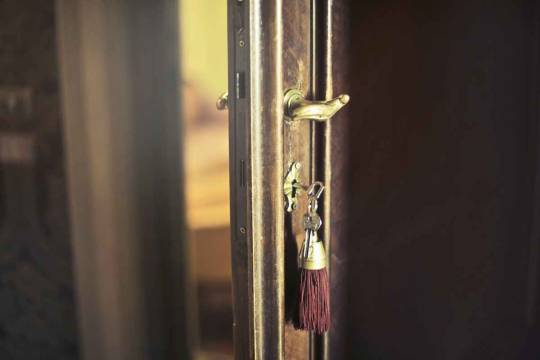
View On WordPress
#bluebeard#bluebeard retelling#bluebeard stories#diverse books#fantasy#Gothic Fiction#gothic horror#Horror#horror books#mr fox#queer fairytales#queer gothic fiction#queer horror#queer retellings#robber bridegroom#sff#strange suitor
1 note
·
View note
Text
Some scholarly notes about the Grimm fairytales (1)
Recently in France (well... for the last two dozen years), the publishing house José Corti has been specializing itself in scientific fairytales collections. While for the study of literary fairytales one would go towards Honoré Champion, when it comes to folktales and fairytales it is José Corti one must check. In their "Merveilleux" collection they have been publishing for the very first time in France or republishing out-of-prints collections of various European fairytales (from Denmark, Spain, Romania, and more) - with a few classics of the "literary" fairytales that marked deeply the evolution of the genre (such as Straparola's Facetious Nights or Ludwig Bechstein's fairytales).
All of that to say, José Corti has in 2009 published the most recent scientific (but for an all-public) edition of the brothers Grimm fairytales. The full collection of their fairytales, translated accurately in French, with annotations about their type/classification, their evolution throughout editions and their predecessors. I can't share all of these annotations with you, of course, but I can share a handful of them, about the most famous stories of the Grimm. They all come from the same person who translated the story in this edition: Natacha Rimasson-Fertin. (Of course my notes might be incomplete but hey, you'll have to buy the books to see the whole thing :p Or check them out at your local library)

The devil with three golden hairs (Der Teufel mit den dre goldenen Haaren)
This story is at the crossroa between the Aa-Th 461 "Three hair from the devil's beard" ; the AT 460B "The quest for fortune" and the AT 93à "Urie's letter/The prophecy".
In the 1812 edition, there were two different versions of this tale. Story number 29 "The story of the devil with three golden hair", told by Amalia Hassenpflug, and number 75, "The phenix", told by her sister Mary. In the second version the devil was replaced by a phoenix, and the hero had to get three feathers. In the 1819 edition the two stories disappeared and were replaced by the version we know today, told by Dorothea Viehmann. Another version that the Grimms had collected in 1812 had a princess falling in love with the woodsman that cuts a tree below her window.
The final episode, where the hero asks three questions to the devil through the old woman, echoes the Pentamerone's "The Seven Doves". Other versions of this story include Asbjörnsen-Moe's "The wealthy Peter Krämer", and Afanassiev's "Marco the Wealthy and Vassili the Unfortunate". The story of the brothers Grimm gathers several references to the Bible: the child throw in the water echoes Moses' abandonment, the letter meant to kill the hero is similar to the one David uses to kill Urie, finally the hair as holders of a being's wisdom and strength is linked to the legend of Samson and Dalila. But many other elements of the story evoke older faiths. The idea of a body of water as the frontier with the Otherworld can be found in the Classical Antiquity with the Greek Charon, and is found in other stories of the volume, such as "Frau Holle" and "The Iron Stove" - it as believed that water formed an obstacle spirits could not cross. The hero's mission recalls a tale of Saxo Grammaticus where Thorkill enters Utgard (the realm of supernatural beings) to steal a hair from the beard of Utgard-loki. The brothers Grimm had noted that the belief in the exceptional fate of a child born with a "hood" was also found in Iceland, where the "caul", called Glückshaut (skin of luck) was the home of a genie that would follow the child all of his life. And indeed, modern research has proven that the name given to this caul, the "fyljia" was also the name of a spiritual double, a tutlar spirit tied to a person or a family. This is why the tradition was to preserve and hide this "pileus naturalis" - in Belgium, it was called a "hem" and its color allowed for divination rituals about the child's future.
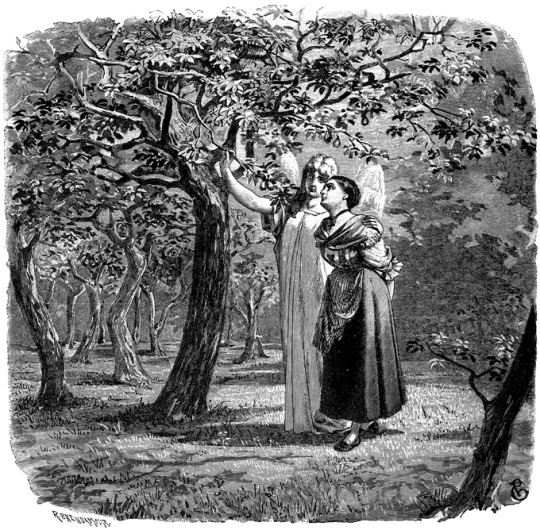
The girl without hands (Das Mädchen ohne Hände)
This fairytale is actually a cross between the AT type 706 "The maiden without hands" and the AT 930 "Urie's letter/The prophecy". The story was created by the brothers mixing two versions from Hesse, one told by Mary Hassenpflug, the other by Dorothea Viehmann. The second version lacks this story's introduction and begins with a father trying to marry his own daughter - when she refuses, he cuts off her hands and breasts, and chases her out of his house. It then follows the story. Meanwhile, the first version differs when the heroine is with her child in the forest: an old man tells her to hug three time a tree with her arms, which makes her hands grow again. He also tells her to only open the door of her house to one who will ask to enter "for the love of God" three times in a row - the king will be forced to do this before entering.
Outside of these two main versions, the brothers Grimm collected three additional ones. In the first, the angel that guides the girl is replaced by a small light that descends from the sky ; and the hands of the girl grow back when she plunges her arms in a stream after seeing a blind mouse enter its water to regain its sight. In the second version, a man is upset at his little girl praying for him day and night, but since she refuses to stop despite his demands, he cuts off her tongue. But she prays in thought and makes the sign of the cross, so he cuts off her right hand, then her arm all the way to the elbow, before banishing her. She is saved by a hunter that hides her in his master's domain and feeds her in secret with his master's dogs. When the master discovers this, he decides to raise the girl as his own child. One day she gives money to a poor man, who tells her she will regain her arm and tongue if she goes to drink of a certain stream, and he gives her a magical staff to protect her. When she returns at the lord's house, he marries her. The third version is about a queen banished by her husband with her two children, and is identical to the legend of saint Helen.
Other international versions of the tale include Zingerle's "The pretty daughter of the innkeeper", Basile's "Penta the one-armed girl" and Afanassiev's "The young girl without hands". There are some versions where it is a man that is mutlated, such as Afanassiev's "The brave without legs and the blind brave". The roots of this story date back to the end of the 12th century, and are located in southern England - this tale was the subject of numerous literary adaptations, the most famous being the verse romance of the 13th century "The Beautiful Helen of Constantinople".
The motif of the child sold to the devil is recurring among the Grimm fairytales - even though the character of the devil can be replaced by another supernatural being, such as in "Rapunzel" or "The Nixie of the Mill-Pond". The idea of offering the first thing one sees upon returning home is as old as the Ancient Testament (Judges). This story bears the signs of a heavy Christianiation, and was clearly inspired by the legend of Saint Genevieve of Brabant, falsefely accused of being unfaithful and condemned to death with her newborn child. The executioners take pity on her and she lives alone in the woods for seven years. As with other tales from the Grimm collection, this story mixes the Christian fantasy (the hands that regrow are treated as a Christian miracle) with pagan fantasy (there are several elements of folk-magic, such as the circle the girl draws around her to be protected from the devil, or the accusations of the queen giving birth to a changeling - a changeling also appears in the third story of "The Elves", KHM 39).

The Robber Bridegroom (Der Räuberbräutigam)
This story belongs to the fairytale type Aa-Th 955, named after it: "The robber bridegroom".
The tale was told to Jacob Grimm by Mary Hassenpflug, and was present as early as the 1810 manuscript. However this first version, that the brothers deemed "incomplete" was replaced from the 1812 edition onward by a new version which mixed two versions from Lower-Hesse. The brothers noted the existence of another version where the robber indicated the road to his house to a princess, by tying ribbons around the trees.
Ludwig Bechstein took inspiration from the brothers Grimm's tale to create his own "The Robber Bridegroom". This fairytale, like "Fichter's Bird", belongs to the "Bluebeard cycle" (several tales that the brothers removed from their first edition also belonged to this cycle).

Fitcher's Bird (Fitchers Vogel)
This tale is a variation of the Aa-Th 311 "The heroine rescues herself and her sisters", usually classified under the "Bluebeard" category.
The final text of the Grimms is actually a mix of two different versions of the same story that was told to the brothers by both Friedrike Mannel and Dortchen Wild. The Grimms noted the existence of a version from Hanovre which goes as follow: a poor woodcutter asks his daughter to bring him his meal in the forest, and to show them the way he places peas on the floor. However dwarves notice this, and change the emplacement of the pea so that their path leads to their grotto. The older girl follows the peas, and become the dwarves' slave. Then we have the Bluebeard "forbidden room" motif, and the story goes as the "Fitcher's Bird" goes, as the dwarves lure the two other sisters to their cave. The last sister sticks the feathers on her body by rolling herself in blood (presumably the blood of the dwarves' victims), and there is no resurrection of the sisters. Everybody that meets her on the way call her "geputzter Vogel". The dwarves hunt the girl down and almost catch her just as she reaches her father's house - she is so fast in closing the door that it cuts a piece of her heel. The Grimms also knew of a Dutch version of the story, translated in German, and that was identical to one of their first-editions tales, "The Murder-Castle".
The translation of the name of the "bird" always caused many problems, due to the difficulty of understanding the expression. The brothers Grimm themselves explained the name of the bird by the Icelandic "Fitfuglar", meaning "birds that swim" - as such, the girl would be called "Fitchers-Vogel" because she looks like a swan". However, other people do not agree with this etymology, some linking Fitcher with "Fitze", the thread. Rimasson-Fertin highlights that the expression "Fitchers Fitze", outside of a simple sonority game, might be two variations of the male name Fritz (the diminutive of Friedrich) - other usual diminutives were Fitze, Fitz and Fiete. The brothers Grimm noted that the motif of the blood that cannot be erased was much older than Perrault's Bluebeard - it could be found as early as the "Gesta Romanorum", where a mother who had murdered her child couldn't erase three blood-drops from her hand, forcing her to wear a glove. This story must be compared to the KHM 40, "The Robber Bridegroom".
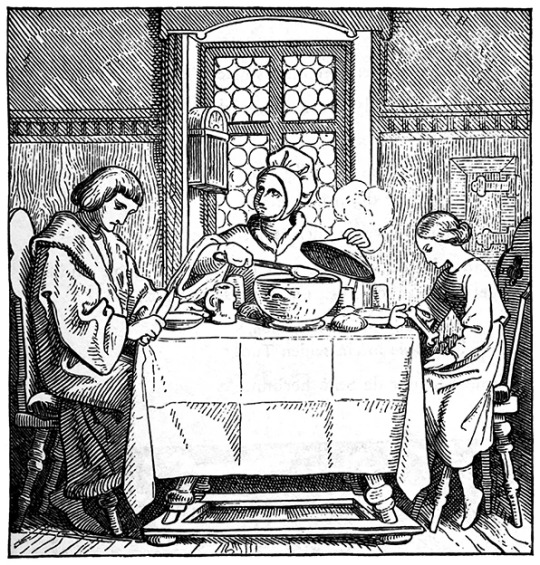
The Juniper Tree (Von dem Machandelboom)
It is the AaTh 720 "My mother killed me, my father ate me".
Just like the tale of "The Fisherman and his wife", this story was written by the painter P. O. Runge, and the brothers Grimm used it as a model for how they should present their own fairy tales. In fact, we can note sentences almost identical between the two tales.
The brothers noted a variation of the story where the stepmother places her daughter near the pot where her brother cooks, and she forbids her from looking inside. But since the pot boils too much, the girl lifts the lid - then her brother's hand reaches out to her from the cauldron. There is yet another version noted by the Grimm where there are three children, not two, and the stepmother sends them pick up strawberries in the wood, promising an apple to whoever comes back first.
The cruelty of this fairytale earned the brothers a serious criticism from Achim von Arnim - who only tolerated such violence because it echoed the one present in Goethe's Faust. The description "red as blood, white as snow" of course echoes the tale of "Snow-White". The brothers Grimm mentionned in their notes that the juniper tree was a plant believed to have the power to bring back youth - and Rölleke noted that the juniper-tree's red berries were used in folk-magic. It seems to be a very ancient tale due to several very old motifs such as the soul returning in the shape of a bird, a resurrection out of bones, and cannibalism. This tale must be compared to "Brother Lustig", "The Singing Bone" and, of course, "The Fisherman and his wife".

Briar Rose (Dornröschen)
Of course, it is the AaTh 410 "Sleeping Beauty".
This fairytale was present as early as the 1810 manuscript, written by Jacob Grimm from a tale told by Marie Hassenpflug. Research has proven that this story is derived from Charles Perrault's own Sleeping Beauty. We also find back in the German story a motif coming from another famous French literary fairytale, madame d'Aulnoy's "The Hind in the Woods/The Doe in the Woods" (also known as the White Doe). In this story a Crayfish/Lobster fairy announces to the queen she will have a child, and later the same fairy curses the princess as she is born - and what a coincidence! In the first edition of "Briar Rose", the animal that announces the princess' birth is not a frog... but a crayfish. Proving that there is a direct link. As for the name of the princess n German, "Dornröschen", "small briar rose", it actually first appeared in the German translation of a 1730 fairytale by Anthony Hamilton (an Irish man who however spoke and wrote French), "Fleur d'épine" (Thorn flower/Briar flower) - it had been translated in 1790. Bolte and Polivka have also noted a comedy by Gryphius from 1660 whch was named "Die geliebte Dornrose", "The beloved briar rose".
In their notes about the fairytale, the Grimm brothers explicitely compare Briar Rose to the legend of Brunhild asleep behind a wall of fire, cursed into a magical slumber by Odin's "sleep-thorn" and woken up by Sigurd, the only one able to cross the wall of flames. The brothers Grimm were also aware of Basile's version of the story, "Thalia, Sun and Moon", which they compared to their own Briar Rose in their notes. The brothers were very fascinated by the consistant naming of the princess' children from Perrault (Dawn, Day) to Basile (Sun, Moon) and compared it to the occurences of "Day, Sun and Moon" as names within the Eddas. However we know that Perrault was heavily inspired by Basile's story when writing his own Sleeping Beauty, and only modified some parts so as to erase the more shocking and "unpleasant" parts (such as the married prince having sex with the sleeping girl). Of course, this story is also to be compared with the 14th century medieval tale of the Roman de Perceforest.
The wise women that appear in this story are the Germanic equivalent of the fairies. In fact, we know that the brothers Grimm carefully avoided (or erased) any mention of "Fee" (the German word for the English "fairy" and French "fée") from their tales, so as to better differentiate them from the French "fairy tales", "contes de fées". By turning the fairies into wise women making predictions at the child's birth, the Grimms notably opened an entire set of symbolism and interpretations linking them to the mythological figures of the Norns, Parcae and Moirai.
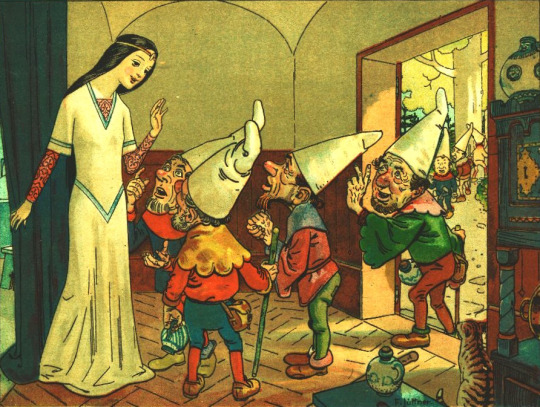
Snow White (Schneewittchen)
Of course, it is the AaTh 709 "Snow-White".
The full editing history of this tale was only "recently" recreated (the book was published in 2009, it was recent back then) in its entirety. We know that it begins in 1808 with a version collected by Ferdinand Grimm, brother of Jacob and Wilhelm, called "Schneeweibchen". It seems Ferdinand might have invented the story on his own. Wilhelm and Jacob then slowly modified it, by adding details from other collected versions, before publishing it in their first edition in 1810 (they did note at the time that it was a Lower-Germany story, and that in Upper-Germany the tale did exist but with the deformed name of "Schliwitchen". When the Grimms did their second edition, the main change they performed onto this story was the modification of the wicked mother into a wicked stepmother - something they also did for "Hansel and Gretel". In fact, from edition to edition the Grimms kept adding adjectives and expressons highlighting the opposition between the girl and the vain queen.
Th Grimms had collected several variations of the tale. One was much closer to the tale of "The Juniper Tree" and in it the queen, as she was with the king on a hunting sled, cut her finger while peeling an apple. In another variation the king and queen were walking by three mounts of snow, than went by three pools of blood, and finally saw three ravens in the sky, and each time the king wishes for a girl with the corresponding colors - soon afterward the couple encountered a little girl fitting this description. The king, immediately attached to her, takes her with him in their royal carriage, but the queen immediately hates her and tries to get rid of her - so she asks the girl to go seek a glove she threw out of the window, and while she is out of the carriage she asks the driver to leave as fast as he can. Then the little girl takes refuge at the seven dwarves' house.
The fairytale existed in German literature before the brothers Grimm published it. Indeed J. A. Musaüs had published in 1782 a fairytale called "Richilde" - and the Grimm were influenced by this tale, since in the margins of their first edition, they noted about Snow-White "It is Musaüs' Richilde". There was also a Snow-White story that had been published in 1809 in a fairytale book by A. L. Grimm (no relationship to the brothers Grimm). The Brothers Grimm did note the striking similarity between this story and the Norse pseudo-historical legend of Snäsridr, the beautiful wife of "Harald with fair hair", a wife that, when she died, stayed in her prime state so that it seemed she was still alive.
This fairy-tale has a very wide area of spreading, as it can be found from Ireland to Turkey passing by central Africa. It is especially present in the literary Italian compilations of fairytales. Basile has three variations of the story in his Pentamerone: "The raven", "Nennillo and Nennella" as well as "The she-cook".
The various virtues that Snow-White shows in this tale made her one of the big role models within the education of bourgeoisie girls in the 19th century - alongside Cinderella, of course. In fact, according to H-J Uther's analysis of the story, it is because of all her virtues that Snow-White's beauty does not fade away and stays undamaged even in death, unlike her wicked stepmother whose vices causes the fading of her charms. Finally, this fairytale is actually the proof that the brothers Grimm did not simply listed their fairytales one after the other in a random order, but deliberately created "bridges" and internal references to create a cohesive world within their book. Indeed, the mention of the snowflakes looking like feathers references "Frau Holle", while the glass coffin can be found back in, of course, "The Glass Coffin", and the blood-drops on the snow evokes "The Juniper Tree".

Rumpelstilzchen
Yes this story is the famous "Rumpelstilskin" (or Rumpelstiltskin? I never know how to write it in English). But why keep the German spelling? Because Rimasson-Fertin has some stuff to say about it: this name is the diminutive form of "Rumpelstilz", a term that Jacob Grimm defined in his "German Dictionary" as being synonymous with "poltergeist" (he noted a similarity between Poltergeist and Rumpelgeist, both designated a very loud spirit). While today "poltergeist" is mostly associated with ghosts, in a much broader way it designate a dwarf, a dead or a devil - or just any kind of phenomenon caused by witchcraft.
This story corresponds to the AaTh 500 "The name of the supernatural being". This fairytale has an interesting evolution history... Jacob Grimm had a version of it as early as 1808, named "Rumpenstünzchen", which was then slightly modified for the 1810 manuscript. This tale was actually the mix of two different versions - and one of these versions had a different ending. The queen didn't sent messengers searching for the dwarf's name, rather the king spotted the little man while returning from hunting on the third day. The Grimm also noted a variation where the initial situation was reversed: a young girl who had to spin hemp but could only manage to spin gold much to everybody's despair, and a small man appeared to promise her a wedding to a king's son in exchange for her firstborn child. It ended in such a way: the queen herself spotted the small man singing his name, jumping around a fire while riding a ladle like a horse. When she guessed his name, he flew out of the window and into the sky, riding the ladle like a witch's broom. We know that the episode of the spinning of the straw was only added by the Grimm in 1812 (it is not in the 1810 version), and that the final scene of the dwarf self-mutilating comes from a story of Lisette Wild and was added in 1819.
The first literary record of this story is a French fairytale published in 1705 and written by Mlle Marie-Jeanne L'Héritier de Villandon. It was "L'Histoire de Ricdin-Ricdon" (The Tale of Ricdin-Ricdon), published in her "La Tour ténébreuse et les jours lumineux" (The Shadowy tower and the luminous days). It had been translated in German by Johann Gottwert Müller in 1790, under the title "Straubfedern", "Ostrich feathers". As for the name "Rumpelstilzchen", it actually originates from Johann Fischart's Grman adaptation of the French "Gargantua", "Geschichtklitterung" (1584) - in it, Fischart lists various children game by name, and mentions a "Rumpele stilt oder der Poppart".
This fairytale type is very present in Western, Central and Northern Europe (British Isles and Ireland included), with also a few spottings in the Baltic countries, China and Japan. The name of the supernatural being always changes from one region or country to the next (in Swiss it is Hans-Öfeli, in Dutch Trillevip, in Swedish Titteliture, in Finnish Tuttirituli, in the Suffolk it is Tom Tit Tot, in Welsh Gnarwynathrot, in Irish it is Eve-Trot or Trit-a-Trot...). It is part of the enormous success of this tale-type: every country has to invent its own brand of nonsensical, un-guessable name. As for the rhymed song through which the dwarf betrays its name, it is found in England as "Nimmy nimmy not / My name is Tom Tit Tot", and in an Afro-American version of North Carolina "I'm so glad that she do not know / That my name is Tabutoe Tambutoe".
The brothers Grimm noted that in Germanic mythology it was typical for underground beings (aka dwarfs) to have names that are not usual among humankind, which is why, again according to them, the dwarf of this story would feel in perfect safety proposing the queen such a game. The rule according to which obtaining the name of a supernatural being means gaining a form of power over them is very common, and is even reused in another one of the Grimm stories: KHM 136, "Iron John". H. Rölleke did an analysis of the names the queen proposes at first: we have the three names of the Magi, aka the Three Wise Men, or King-Magi, which gives a Christian setting to the story, and could also serve as a metonymy for all the saint names found in the Christian calendar. As for "Heinz" and "Kunz", Rölleke sees in them the diminutives of the names of the medieval emperors Heinrich and Konrad, which used to be some of the most popular male names among German-speaking countries.

All-Kinds-of-Fur (Allerleirauh)
It corresponds to the AaTh 510B "The dresses of gold, silver and stars", also known as "Donkey Skin", after the famous Charles Perrault fairytales.
The story we read today was the one told to the Grimm by Dortchen Wild, but there was a variation of it told to the brothers by Jeannette Hassenpflug, "Princess Mouse-Skin", which was present in the 1812's edition of the volume (n°71) but was then moves to the annotations as a mere mention. The version of the story from the first draft (the 1810 manuscript) was called "Allerlei Rauch", "All Kinds of Smoke", and was heavily inspired by one of the tales present within the novel "Schilly" by Carl Nehrlich.
The line "God forbade a father from marrying his daughter. Nothing good can come from this sin which will cause the kingdom's decadence" was added in the 1819 edition, and references a tale of Albert Ludwig Grimm called "Brunnenhold und Brunnenstark". The brothers Grimm insisted even more on the condamnation of the sin of incest when rewriting the story for their "small collection" for kids, and also insisted heavily upon a political extension of such a decision, which would damage the state itself. It is actually an allussion to the failure of the Frankfort Parliament, which had been gathered in 1848 at the Paulskirche in an attempt to create a constitution for all of Germany - to which Jacob Grimm had taken part.
A variation of the story collected in Paderborn has the last coat made of all the furs of the kingdom, plus moss and various forest-related material. In this version, the heroine puts the cloak on top of her three beautiful dresses before fleeing, and she hides in an empty tree where she is discovered, not during a hunting party, but by woodsman that cut off the tree she was sleeping into, to bring wood to the king. All-Kinds-of-Fur works in the castle's kitchen but one day as she is preparing the soup, the king has her sit on his chair so she can delouse him (a motif also present in "The Devil with Three Golden Hair). As she does, the king glimpses the beautiful shining dress under the cloak's sleeve, and this is how he discovers the girl's true appearance. Another variation of the story yet, also collected in Paderborn, has the heroine pretending to be mute. One day the king hits her with a whip, it rips apart the coat, revealing the golden dress underneath.
Not all the German versions of the story include the incest motif. In Musaüs' take on the story, "Die Nymphe des Brunnens", "The Nymph of the Well", the heroine leaves her father's castle because it has been destroyed. Her godmother, an undine, gifts her a small magical box and when she leaves the ball she says "Night behind me and day before me / Might nobody see me!". As for the version of Hassenpflug, "Princess Mouse-Skin", it begins as the KHM 179, "The Goose-Girl at the Well": a king wants to know which of his three daughters love him the most, the first says she loves him more than the whole kingdom, the second more than pearls and precious stones, the third more than salt. The furious father has the last princess be sent into the woods to be killed, but the servant tasked with the execution spares her out of pity, and gives her, by her request, a coat made of mice skin. The rest of the story goes like within "All-Kinds-of-Fur", except for the final wedding, to which the father-king is invited. All the dishes served to him are without salt, and he ends up saying he prefers to die rather than continue eating without salt. The princess-daughter reveals herself and points out how he tried to had her killed for loving him more than salt. Her father begs her for forgiveness, and the tale ends with her accepting.
The motif of the incest can, however, be found back in a variation of the KHM 31 (The Girl Without Hands) that the Grimms collected, and where the father mutilates the daughter for refusing to marry him. The motif of the king trying to marry his own daughter has been attested in many, many European stories ever since the 12th century. As for the boots that are thrown in the heroine's face in the Grimm story, while in the final edition it has no follow-up, in the 1812 edition it was a recurring element forming a motif within the tale. Another German version of the story that preserved this structure that the Grimms erased is the story collected by Vernaleken, "Throw-Broom, Throw-Brush and Throw-Comb". In it the king throws out of anger at the face of the heroine (Adelaide) a broom, a brush and a comb. Every time she goes to the ball, she changes her pseudonym to fit which item hit her (one night she is "Throw-Broom", another she is "Throw-Brush", etc...). There are many, many variations of the story containing such a "name play".
Other famous examples of this variation, outside of Charles Perrault's Donkeyskin, include Straparola's "The maiden in the chest", Basile's "The She-Bear", Afanassiev's "Pig-Skin".
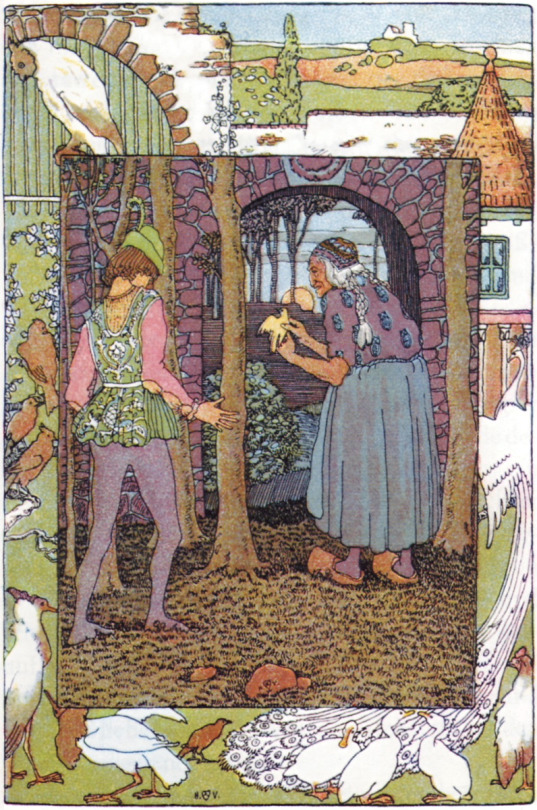
Jorinde and Joringel (Jorinde und Joringel)
It corresponds to the AaTH 405, named and created after this story, "Jorinde and Joringel".
The interesting thing with this story is that the brothers Grimm did not collect it from a direct source. Rather they lifted it, to the exact word, from the autobiography of Johann Heinrich Jung, "Jugend/Youth", published in 1779. The brothers deemed that the way Jung-Stilling had written the tale was the "perfect" way to tell the story, according to their definition of a fairytale. Though they did note the existence of a version of the story told in Schwalm - but which differs very little from the story of Jung-Stilling.
The brothers Grimm themselves noted a similarity between this story, and the KHM 123, "The Old Woman in the Wood". Rimasson-Fertin notes that the witch in this story is to be compared to the ones appearing in "Hansel and Gretel" and in "Little Brother and Little Sister". As for the name of the demon the witch invokes, "Zachiel", H. Rölleke identified it as a form of "Zachariel", a demon name coming from the very popular 17th century demonology grimoire "Clavicula Salomonis", "The Clavicles of Salomon".
#brothers grimm#grimm fairytales#brothers grimm fairytales#german fairytales#sleeping beauty#briar rose#snow-white#snow white#jorinde and joringel#all kinds of fur#the juniper tree#the devil with three golden hair#the three golden hair of the devil#the robber bridegroom#the maiden without hands#the girl without hands
46 notes
·
View notes
Text









Ada Vogel 🐦⬛
Parent’s Story: The Robber Bridegroom
Powerful Qualities: Fearless, Independent, Confident
Roommate: Wilma Scarlet
Secret Heart’s Desire: I would like for people to see me as less of a damsel in distress.
My “Magic” Touch: I can also find my way out of the woods, literally. You could put me blindfolded in the middle of nowhere and I can find my way out.
Storybook Romance Status: There are lots of cute boys, so I have a good chance of finding someone.
“Oh Curses!” Moment: My story is kind of dark, so I always make sure I carry something with me to protect myself from harm.
Favorite Subject: Study Ball. It gives me time to practice my self defense skills.
Least Favorite Subject: Hexonomics. Professor Rumpelstiltskin makes that class unnecessarily hard.
Best Friends Forever After: Mildred Goldstraw, Wang Yan Mei, and my roommate Wilma
#my posts#ever after high#art#aesthetic#moodboard#eah#ada vogel#girl in white#royal#the robber bridegroom#mildred goldstraw#background characters#eah oc#wilma scarlet
12 notes
·
View notes
Text


Arthur Rackham (1867-1939)
Illustrasjoner til det tyske folkeeventyret “Røverbrudgommen” fra brødrene Grimm.
Les eventyret på EventyrForAlle.no: https://eventyrforalle.no/brodrene-grimm/grim043
Illustrations for the German folk tale “The Robber Bridegroom” from brødrene Grimm.
#eventyr#fairy tales#illustrasjoner#illustrations#arthur rackham#brødrene grimm#folkeeventyr#folklore#folktales#folk tales#røverbrudgommen#the robber bridegroom#der räuberbräutigam
3 notes
·
View notes
Text
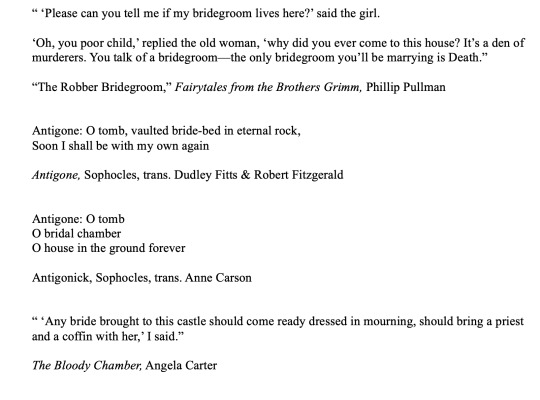
be bold, be bold, etc.
#be bold be bold is technically from mr. fox not the robber bridegroom but#mr. fox is here in spirit too#parallels#antigone#antigonick#anne carson#the robber bridegroom#the brothers grimm#phillip pullman#the bloody chamber#angela carter#novel tag#bluebeard#mr. fox#once there was and once there wasn't#i think that's going to be my new fairytale/folklore tag
14 notes
·
View notes
Note
What if Disney adapted The Robber Bridegroom?
I'm gonna level with you, anon, adapting murder tales into child friendly animations really isn't the way to go. It robs them of their soul.
Personally I don't think they're even particularly suited to be adapted into any visual medium. The whole point of them is to tell them to a frightened audience or to read them in the half-dark, grimacing at the page at all the blood, kidnapping and deceit.
If this is a genre that interests you, I reccommend having a look at the following:
Ashliman's roundup of tales like The Robber Bridegroom (ATU tale type 955), wherein a maiden narrowly escapes a murderous suitor and sees to it that he is vanquished.
Ashliman's roundup of tales like Bluebeard (ATU tale type 312/A), wherein the woman is rescued from her would-be murderer by her brother(s).
Ashliman's roundup of tales like How the Devil Married Three Sisters (ATU tale type 311), in which three sisters marry a Bluebeard type man, one after the other, but the youngest manages to free/revive her sisters and they all escape. (These are my favourites, because you get to horror at the horror and then see the victims fight back, survive and win.)
If this is not your type of genre, please read them with caution, they are very violent (by folktale standards).
Personal ramble about this type of tale under the cut:
Obviously these all come with huge content warnings for femicide and domestic violence, and in multiple of the type 955 tales cannibalism. They also all end in the defeat of the abuser, usually his violent death, and that is imperative. The heroine wins and the antagonist does not. These are survival tales.
Another important element is that these abusers are often rich, and the women poor(er), and her parents either order, condone or fail to prevent the marriage/engagement. These are horror stories to revel in, emphasising fear and gore, but most of them also carry a clear warning and moral about not believing and/or listening to your daughters. (Of course very rooted in the various times they originated.) There is often (in my opinion) too much focus on the curiosity/disobedience part of the plot, and I blame Perrault for that.
I'm a big fan of retellings and adaptations and I think storytellers should have all the freedom they wish in this, but I personally prefer taking a Beauty and the Beast type tale for the dark romance vibes instead of one of these. The antagonists of almost all of these stories are serial killers and to redeem them you are all but forced to change that, which changes their entire archetype, and the story with them. Which is fine if that's what you want, but then there are so many other stories to choose from that did not include these levels of abuse and horror in the first place.
36 notes
·
View notes
Text

Jeremy Jordan as Jamie Lockhart/The Bandit of the Woods (The Robber Bridegroom)
9 notes
·
View notes
Photo

Five of Swords. Art by Nara Lesser, from Neurotic Owl’s Faerytale Tarot.
I was casting around for what to do with this one and sort of thinking about whether it would fit for Bluebeard, which led to me rereading variants and then remembering The Robber Bridegroom. It’s not one of my favorite stories – none of the Bluebeard types are – but I do like that for once we get a clever, helpful old woman who’s not secretly a fairy or anything special. I do sort of have to wonder why she’s not helping any of the other girls this band of robbers apparently brings home to EAT, but I’m going to give her the benefit of the doubt and assume she doesn’t usually get the chance. Anyway, in story terms we need the (urk) severed finger with the gold ring on it that our surprisingly chill bride takes with her to prove what’s going on.
It’s very much worth a read if you have the stomach for dark and bloody fairytales; there’s some very vivid and intriguing imagery and I really did want to work in the three glasses of wine – one white, one red, and one yellow – that kill the last victim, but I was already juggling a lot of elements and adding anything else just got too crowded.
#Nara Lesser#Neurotic Owl’s Faerytale Tarot#Five of Swords#Five#Swords#Minor Arcana#Tarot#Folklore#The Robber Bridegroom
6 notes
·
View notes
Text
u know it's kind of funny how ppl talk abt how dark the original (grimm) versions of well known fairytales are and like. people thought that in the 1800s too LMAO like the grimm brothers republished their first volume 😭😭 we read a compilation of some of the grimm fairytales when we were younger and 'the robber bridegroom' has always stood out to us. I mean it's arguably one of the most disturbing stories in the collection. and we read it when we were ten. but idk we actually really like it
#weve been on a fairytale kick lately#also interesting to note that in the republished version the brothers grimm changed a lot of#“mother” characters to be “stepmothers”#namely the villains that were mother figures#but thats like. a whole nother post. an essay#anyways recommend reading the robber bridegroom honestly it feels more like a. horror short story to us than an oral tale#probably bc of how the grimm brothers wrote everything though LMAO#confluence.txt
1 note
·
View note
Text
From a post I made on Reddit

0 notes
Text

I’m lousy with anniversaries. I rarely acknowledge them. I never celebrate them, but today marks a special event that changed my life for the better. On February 24, 2004 I received an e-mail that notified me that I got cast as “Little Harp'' in The Robber Bridegroom at the Muncie Civic Theatre. I couldn’t believe it. After years of trying and failing at assorted auditions, I actually got a part in a show! And a musical at that! This was a big deal for me, but little did I know at the time just how big a deal it was.
By getting cast in that one show, my journey into the realm of community theater soon began and for the past twenty years this wonderful journey continues to enrich my life in numerous ways. I have been blessed to be part of so many great productions and have had the pleasure of working with so many talented and creative people. Even better, I have become good friends with many of these fine folks and, as much as I love to perform on stage, I treasure these precious friendships even more.
So I want to take a moment to thank Darrin Murrell and Julie Lyn Barber for taking a chance on a fat cartoonist twenty years ago and giving me the opportunity to become part of a creative community that strengthens my imagination, challenges my meager talents, and connects me to some incredible people. It is truly a gift that I hope I can be part of until the end of my days. Thank you to all my friends, my collaborators and fellow travelers who made these past twenty years, on stage and off, so rich and meaningful for me. You all mean more to me than I can truly express.
The poster drawing for The Robber Bridegroom was by Eugene Mumaw.
0 notes
Text
Toxic masculinity in fairytales: Prince Charming
Prince Charming? Why is he here among the list of fairytale villains? Well... It is a long story. I originally wanted to make a post about the Robber Bridegroom character, to complement my Bluebeard post... However, since for this year I focus on mediatic adaptations of fairytales, I realized there wasn't enough apparitions of the poor Robber... @grimoireoffolkloreandfairytales suggested doing the "False Hero" archetype, and I was all down for it since there's a lot of tales about this type... Unfortunately it turned out to be a tad bit more nebulous than planned.
However, by searching around for these two types I noticed how in most fairytale media, a similar character-type popped up, what TV Tropes called "Prince Charmless": a parody, subversion or take-down of the "Prince Charming" archetype or ideal. The romantic ideal, the ultimate savior, becomes the ultimate jerk or a debauched pervert. I will also throw in a couple of other no-so-nice-guys and sleazy faces.

















22 notes
·
View notes
Text
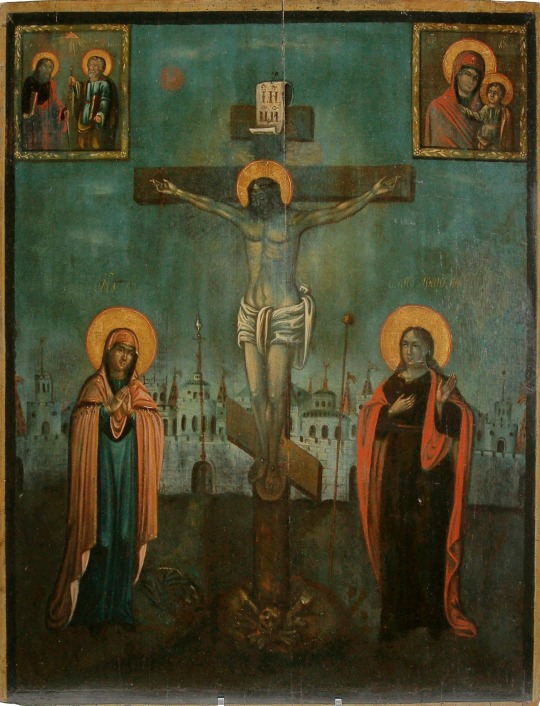
“The cross is the principle of our salvation; the cross is the basis of innumerable goods. Because of it, we, who were previously deprived of honor and rejected, are now accepted into the title of sons; because of it we are no longer in delusion, but have known the truth; because of it we, who before worshiped trees and stones, now know the Creator of all things; because of it we, who have been the servants of sin, have been brought into the freedom of righteousness; finally, because of it, the earth became heaven.
It freed us from delusions, it guided us to the truth, it reconciled God and people, it pulled us out of the depths of vice and raised us to the very summit of virtue, it destroyed demonic delusion, it destroyed deception. Because of it, there is no more smoke, the smell of burned idol offerings and the shedding of blood of unscrupulous animals, but there are spiritual services, chanting and prayers everywhere. Because of it, the demons were forced to flee, because of it, the devil was banished, because of it, human nature began to compete with the angelic one, because of it, virginity gained power on earth. Namely, since He was born of a Virgin, human nature has come to know this path to virtue. It enlightened us who sat in darkness, reconciled to God us, who fought against Him, it made us, who were far away, come closer, it made us, who were strangers, the citizens of heaven; it has ended our war, it has become a pillar of peace for us. Because of it, we are no longer afraid of the fiery arrows of the devil, since we have found the source of life; because of it we stopped being widows, because we have found the Bridegroom. Because of it, we are no longer afraid of the wolf, because we know the Good Shepherd. And the Lord Himself says: “I am the Good Shepherd” (John 10:11). Because of it, we are no longer afraid of the tyrant, since we are sitting next to the King.
Do you see how much good the cross has caused us? That is why we celebrate it justly.”
—St John Chrysostom, “Sermons on the Cross and the Robber”
84 notes
·
View notes
Text
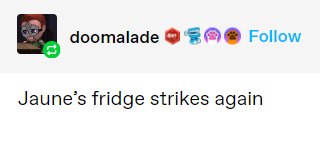

I'm sorry, I just had this wild CreepyPasta idea for Jaune lmao
He's the real Robber Bridegroom this whole time. COUNT YOUR DAYS, SCHNEE.
41 notes
·
View notes